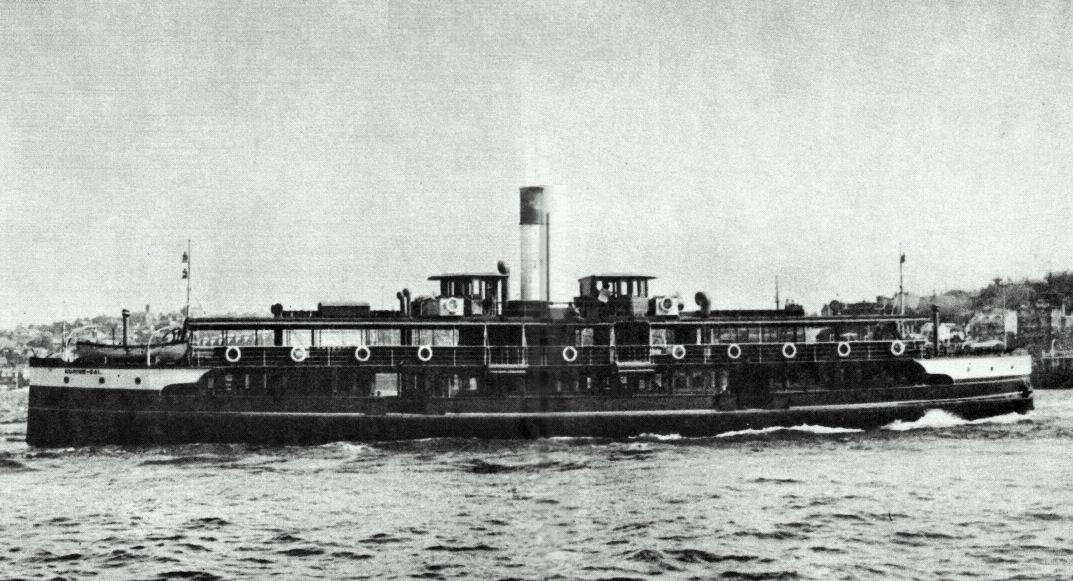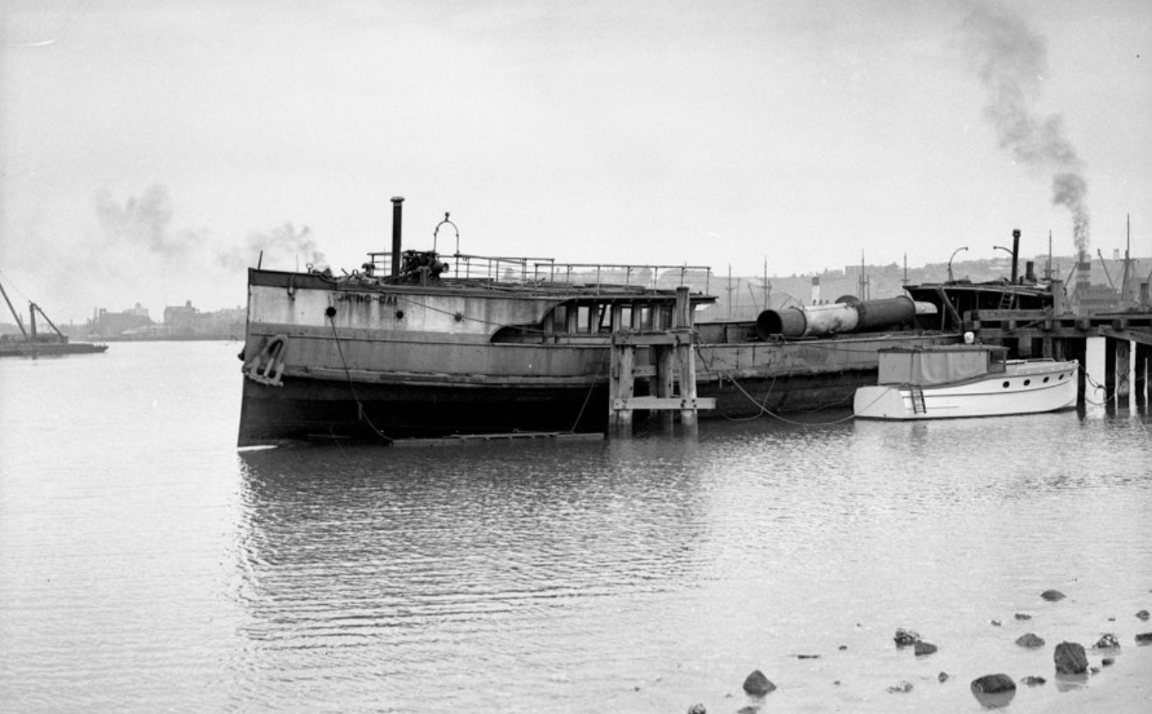SS Kuring-gai on:
[Wikipedia]
[Google]
[Amazon]
''SS Kuring-gai'' was a
 ''Kuring-gai'' was ordered by the Port Jackson Co-operative Steamship Co. Ltd, which became the
''Kuring-gai'' was ordered by the Port Jackson Co-operative Steamship Co. Ltd, which became the
/ref> The high standard of passenger accommodation including polished timbers, mirrors and electric lights was greatly appreciated by passengers. In 1905, ''Kuring-gai'' overshot the wharf at Circular Quay and became stuck in a hole that the new ''Binngarra'' had created when it too crashed four days earlier. ''Kuring-gai'' was freed by the paddle steamer, ''
File:Ferry Kuringai.jpg, Near Bradleys Head, steaming towards
 She was tied up and hulked in 1934. The wooden superstructure was demolished and in World War II, US forces used her in New Guinea as a storage barge.Newcastle Herald
She was tied up and hulked in 1934. The wooden superstructure was demolished and in World War II, US forces used her in New Guinea as a storage barge.Newcastle Herald
/ref> After the War, the vessel was towed back to Newcastle, moored at
ferry
A ferry is a boat or ship that transports passengers, and occasionally vehicles and cargo, across a body of water. A small passenger ferry with multiple stops, like those in Venice, Italy, is sometimes referred to as a water taxi or water bus ...
that served on the Sydney
Sydney is the capital city of the States and territories of Australia, state of New South Wales and the List of cities in Australia by population, most populous city in Australia. Located on Australia's east coast, the metropolis surrounds Syd ...
to Manly run from 1901 to 1928.
An iron framed, steel-plated double-ended screw ferry, it was the archetype of the familiar Manly ferry
The Manly ferry service (numbered F1) operates on Sydney Harbour, connecting the Sydney suburb of Manly with Circular Quay in the CBD, a journey of seven nautical miles.
History
In 1853, Henry Gilbert Smith chartered the wooden paddle whee ...
shape of the 20th century.
The name ''Kuring-gai'' is derived from the "Guringai
Kuringgai (also spelled Ku-ring-gai, Kuring-gai, Guringai, Kuriggai) (,) is an ethnonym misapplied to an Indigenous Australian people who once occupied the territory between the southern borders of the Gamilaraay and the area around Sydney, ...
" Aboriginal people
There is no generally accepted definition of Indigenous peoples, although in the 21st century the focus has been on self-identification, cultural difference from other groups in a state, a special relationship with their traditional territ ...
who were thought to be the traditional owners
Native title is the set of rights, recognised by Australian law, held by Aboriginal and Torres Strait Islander groups or individuals to land that derive from their maintenance of their traditional laws and customs. These Aboriginal title rig ...
of the area immediately north of Sydney. More contemporary research suggests that this was not the case.
Design and construction
 ''Kuring-gai'' was ordered by the Port Jackson Co-operative Steamship Co. Ltd, which became the
''Kuring-gai'' was ordered by the Port Jackson Co-operative Steamship Co. Ltd, which became the Port Jackson and Manly Steamship Company
The Port Jackson and Manly Steamship Company (PJ&MSC) was a publicly listed company that operated the Manly ferries in Sydney, Australia. After being taken over by Brambles Industries, the ferry service was eventually taken over by the State G ...
. The vessel was designed by renowned naval architect This is the top category for all articles related to architecture and its practitioners.
{{Commons category, Architecture by occupation
Design occupations
Occupations
Occupation commonly refers to:
*Occupation (human activity), or job, one's rol ...
, Walter Reeks
Walter Reeks () was one of the earliest Naval architecture, naval architects in Australia and is known for designing yachts, ferries and coastal ships.
He was born in Christchurch, Dorset, Christchurch, England and migrated to Australia in 1885. ...
and was a development of Reeks' previous Manly ferry, the wooden '' Manly''. ''Kuring-gai's'' wheelhouses were located immediately adjacent either side of her single funnel. She was the first Manly ferry to have gangway exits on both upper and lower decks. The subsequent '' Binngarra''-type of vessels were larger versions of ''Kuring-gai'' but with wheel houses at the far ends of the upper deck.
Her basic design was emulated on eleven ferries that formed the twentieth century fleet of Manly ferries; namely the ''Binngarra''-type ferries, the two Dee Why-class ferries and the South Steyne. This layout is also seen in the four current Freshwater-class ferries introduced in the 1980s and still operating.
''Kuring-gai'' was built in 1901 at Mort's Dock and Engineering in Balmain. Her triple expansion steam engines, also supplied by Mort's Dock, generated 85 hp. She reached 15.66 knots on her trials on 28 April 1901.
Service life
''Kuring-gai'' ran her first revenue trip to Manly on the 11 May 1901.ferriesofsydney.com/ref> The high standard of passenger accommodation including polished timbers, mirrors and electric lights was greatly appreciated by passengers. In 1905, ''Kuring-gai'' overshot the wharf at Circular Quay and became stuck in a hole that the new ''Binngarra'' had created when it too crashed four days earlier. ''Kuring-gai'' was freed by the paddle steamer, ''
Brighton
Brighton ( ) is a seaside resort in the city status in the United Kingdom, city of Brighton and Hove, East Sussex, England, south of London.
Archaeological evidence of settlement in the area dates back to the Bronze Age Britain, Bronze Age, R ...
''.
''Kuring-gai'' was reboilered in 1922. Her capacity of 1,228 passengers became too small for the booming Manly route, particularly in comparison to the larger ''Binngarra'' class ferries that had been subsequently introduced. Following the arrival of the fast and big ''Dee Why'' and ''Curl Curl'' from Scotland, she was sold to Newcastle Ferries Ltd in 1928 and used as a ferry at Walsh Island, now known as Kooragang. She was also used to run excursions to Raymond Terrace
Raymond Terrace, locally known as "Raymo” or "The Terrace", is a town in the Hunter Region of New South Wales, Australia, about by road north of Newcastle, New South Wales, Newcastle on the Pacific Highway, Australia, Pacific Highway. Establi ...
, Nelson Bay Nelson Bay may refer to:
*Nelson Bay, New South Wales
Nelson Bay is a significant township of the Port Stephens local government area in the Hunter Region of New South Wales, Australia. It is located on a bay of the same name on the southern ...
and Broughton Island.
Circular Quay
Circular Quay is a harbour, former working port and now international passenger shipping terminal, public piazza and tourism precinct, heritage area, and transport node located in Sydney, New South Wales, Australia, on the northern edge of the ...
File:Kuringai 2 from NLA.jpg, on Sydney Harbour, 1920
File:Ferries KURING-GAI and KURNELL at Walsh Island Dockyard.jpg, With ferry ''Kurnell'' at Walsh Island Dockyard (between 1928 and 1934)
Demise
 She was tied up and hulked in 1934. The wooden superstructure was demolished and in World War II, US forces used her in New Guinea as a storage barge.Newcastle Herald
She was tied up and hulked in 1934. The wooden superstructure was demolished and in World War II, US forces used her in New Guinea as a storage barge.Newcastle Herald/ref> After the War, the vessel was towed back to Newcastle, moored at
Hexham
Hexham ( ) is a market town and civil parish in Northumberland, England, on the south bank of the River Tyne, formed by the confluence of the North Tyne and the South Tyne at Warden nearby, and close to Hadrian's Wall. Hexham was the administra ...
and at one point sank in the mud near Hexham Bridge
Hexham Bridge is a road bridge in Northumberland, England linking Hexham with the North Tyne valley. It lies north of the town of Hexham and is the main access to the A69 road, A69 Bypass (road), bypass.
History
The Tyne was crossed by two fe ...
where she is still visible.
Citations
References
* * *External links
* {{DEFAULTSORT:Kuring-gai Ferry transport in Sydney History of Sydney Ships built in New South Wales 1901 ships Ferries of New South Wales